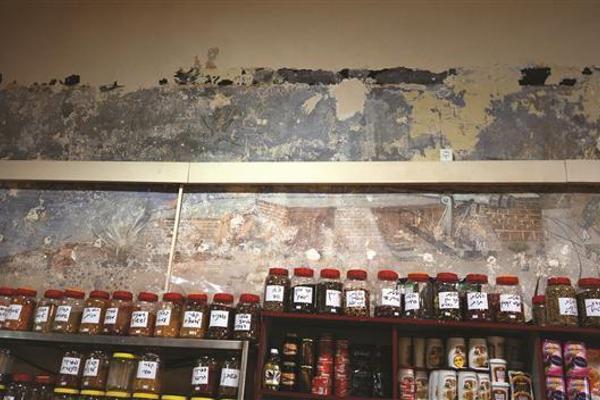Wall painting by Ottoman officer found in Haifa
HAIFA - Anadolu Agency


The 10-meter painting by the Ottoman officer has not been entirely revealed and $10,000 is needed to continue works, according to the Haifa History Club’s Eli Liran.
Locals in Haifa have discovered a large painting dating back from World War I in a nuts store in the coastal Israeli city.The 10-meter-wide and three-meter-high painting, which covers the entire wall, depicts an air attack by the British army against the Ottoman army during World War I.
The painting was revealed by a university student who had come to the store for shopping. Seeing a miniature soldier’s head beneath the peeled-off plaster on the wall, the student called a friend who is an expert on wall paintings. The expert went to the store the following day to examine the wall and said a bigger painting could be concealed beneath the plaster.
The university student, the expert and Haifa History Club member Eli Liran obtained permission from the store’s owner to begin peeling off the plaster on the wall.
After a long and detailed work, the painting by an Ottoman soldier was finally revealed.
Dozens of miniatures depicting Turkish warplanes bombing British planes or dead and wounded Turkish soldiers being carried on stretchers were found. Below the painting was the signature of the painter, “Edip Kemal,” and the words “Hotel Zahara Syria.”
‘Building is the same’
Speaking about the issue, Liran said: “We have examined a Hebrew newspaper from this era and found out that Edip Kemal was an Ottoman officer of Transcaucasian origin. He went to Damascus with the Ottoman army, which lost the war and withdrew to Damascus, but he returned to Jerusalem in 1933 and then to Haifa. He operated this nuts store as a boxing club. We couldn’t really understand why he used the expression ‘Hotel Zahara Syria.’ But then we realized that the building was used as a hotel in this era and it was a branch of the Hotel Zahara chain. We saw that the pictures of the hotel in Damascus and this building were exactly the same.”
Liran said they needed $10,000 to reveal the whole painting. “The painting has not been entirely revealed yet. We can only see two-thirds of the painting. When the work is done, the painting should be removed from the wall and moved to another place. I hope that Turks will support us because it belongs to them. The Haifa Municipality showed no concern for it. Maybe the Turkish General Staff can inform us about the painter, Edip Kemal. They may confirm to us whether he worked here or not.”
Haifa was a port city where the Ottoman army set up a base for sea transportation until the end of World War I. After the war, the region was mentioned as a “Turkish region” by locals. Later on, the barracks of the Turkish army and other structures were demolished systematically to remove the traces of Turks in the region.
